Do you ever wonder about the impact of carbon dioxide on our oceans? Did you know that rising CO2 levels are causing a major problem called ocean acidification? In this blog, we’ll explore how ocean acidification affects marine life and what we can do to solve this issue. Join us as we dive into the other CO2 problem!
Key Takeaways
- Ocean acidification happens when CO2 from human activities like burning fossil fuels dissolves in seawater, forming carbonic acid and lowering pH levels.
- This increase in acidity can harm marine life; creatures struggle to build skeletons and shells due to less available carbonate ions, which can upset entire ecosystems.
- Mangroves are important for carbon storage but are threatened by ocean acidification, risking their ability to reduce atmospheric CO2 levels.
- Reducing CO2 emissions through renewable energy use, protecting mangrove forests, and restoring marine habitats are vital steps to combat the effects of ocean acidification.
- Collaborative efforts between governments, scientists, communities and individuals along with education on sustainability will help manage the impacts of rising atmospheric CO2 on our oceans.
Definition of Ocean Acidification
Ocean acidification is a process where the pH levels of seawater drop due to increased carbon dioxide (CO2) in the atmosphere. Most of this CO2 comes from human activities, such as burning fossil fuels and deforestation.
When CO2 mixes with seawater, it forms carbonic acid, leading to more acidic oceans.
As acidity rises, it alters the chemical speciation in seawater. This means that some substances which used to dissolve easily may not do so anymore. Such changes can have profound effects on marine life; for example, creatures like corals and shellfish struggle to build their skeletons and shells when there’s less available carbonate – an essential building block for them.
Ocean acidification could therefore pose serious risks to entire marine ecosystems if current trends continue unchecked.
Link to Rising Atmospheric CO2
Each time we burn fossil fuels such as coal, oil, and gas, carbon dioxide (CO2) is released into Earth’s atmosphere. These emissions have spiked dramatically since the Industrial Revolution, leading to an increase in atmospheric CO2 levels.
This excess CO2 doesn’t just stay up in the sky; a significant amount gets absorbed by our oceans. When this happens, chemical reactions take place that reduce seawater pH and alter carbonate chemistry – the very foundation of many oceanic life forms.
The process of turning CO2 into carbonic acid also lowers the availability of ions needed for marine creatures to build shells and skeletons. It affects everything from tiny plankton at the base of the food web to majestic coral reefs that support thousands of species.
As a result, rising atmospheric CO2 directly ties to changes in ocean acidity and has profound potential consequences for marine ecosystems worldwide.
Biological Impacts of Ocean Acidification
Changes in Seawater Chemical Speciation and Effects on Marine Plants and Animals highlight the severe impact of ocean acidification on marine life, making it imperative for us to understand its consequences.
Read more about the biological impacts of ocean acidification to gain insight into this pressing environmental issue.
Changes in Seawater Chemical Speciation
Seawater chemical speciation is shifting due to increased carbon dioxide emissions. Carbonic acid formation is altering the ocean’s pH levels, impacting marine plants and animals. This acidification effect disrupts biogeochemical cycles, threatening the delicate balance of marine ecosystems.
The geological record of ocean acidification provides stark evidence of its damaging effects on our oceans.
Understanding these changes in seawater chemical speciation highlights the urgent need for action to mitigate the impacts of ocean acidification. Collaboration and education are essential steps towards a sustainable future where our marine environments can thrive once more.
Effects on Marine Plants and Animals
Ocean acidification impacts marine plants and animals by altering the chemical composition of seawater. Decreased pH levels lead to reduced availability of carbonate ions, hindering the ability of marine organisms such as corals, shellfish, and plankton to build their calcium carbonate shells and skeletons.
This can disrupt entire ocean ecosystems and affect food webs, including fish that rely on these organisms for sustenance.
Marine plants like seagrasses and phytoplankton are also affected by ocean acidification. Changes in seawater chemistry can influence photosynthesis rates and growth, potentially impacting oxygen production and essential habitat for various marine species.
Climate Change Impacts on Marine Ecosystems
Acidification is a predictable consequence of climate change, but there are still uncertainties compared to climate change forecasts. To learn more about the impacts of ocean acidification on marine ecosystems, keep reading.
Acidification as a Predictable Consequence
Ocean acidification, caused by the absorption of excess carbon dioxide in seawater, poses a predictable consequence for marine ecosystems. As atmospheric CO2 levels rise, more CO2 dissolves into the oceans, leading to lower pH levels and increased acidity.
This impacts marine life at all levels of the food chain, from corals and shellfish to fish and marine mammals. The consequences are foreseeable, as rising atmospheric CO2 directly correlates with increasing ocean acidity.
Marine organisms like corals and shellfish struggle to build their calcium carbonate skeletons or shells in acidic conditions. Additionally, changes in seawater chemical speciation have detrimental effects on vital processes such as photosynthesis and respiration in marine plants and animals.
Uncertainties Compared to Climate Change Forecasts
Climate change forecasts are based on a variety of complex models and data, but uncertainties still exist. Unlike climate change predictions, ocean acidification forecasts face additional challenges due to the complexity of marine ecosystems and their responses to changing pH levels.
Understanding the full extent of biological impacts such as those on marine plants and animals is essential for accurate forecasts. Nevertheless, ongoing research and monitoring are crucial for better comprehension of these uncertainties.
The complexities surrounding ocean acidification compared to climate change create significant challenges in predicting its future impact. While climate science has made significant strides in forecasting changes, there remains a need for further study and collaboration within the scientific community to improve our understanding of the potential implications of ocean acidification.
Carbon Cycling and Sequestration in Mangrove Forests
Mangroves play a crucial role in storing carbon, but ocean acidification threatens their ability to do so. To learn more about this important issue and potential solutions, continue reading the full blog.
Importance of Mangroves in Carbon Storage
Mangroves play a crucial role in storing carbon, helping to mitigate the impacts of rising atmospheric CO2 levels. The intricate root systems of mangrove forests efficiently trap and store carbon, making them vital in the fight against global warming.
By holding significant amounts of carbon within their soils, mangroves contribute to maintaining a balanced carbon cycle and reducing CO2 emissions into the atmosphere.
Furthermore, the ability of mangroves to sequester carbon provides valuable support for marine ecosystems facing ocean acidification. As these coastal habitats face increasing threats from changing seawater acidity levels, preserving and restoring mangrove areas can significantly aid in safeguarding marine environments against further degradation.
Effects of Acidification on Mangroves
Mangroves play a crucial role in sequestering carbon, aiding the fight against climate change. Acidification of ocean waters poses a substantial threat to these vital ecosystems. Elevated levels of CO2 lead to reduced pH levels in seawater, impacting the ability of mangroves to effectively store carbon.
This disturbance may compromise their resilience and overall health, with potential knock-on effects on the biodiversity they support.
Under acidic conditions, mangroves may struggle with nutrient uptake and growth. Their ability to trap sediments can also be affected, potentially leading to increased coastal erosion and loss of critical habitat for marine life.
Solutions to Ocean Acidification
Reduction of CO2 Emissions and the restoration and protection of marine ecosystems are essential steps in combating ocean acidification. Read more about these solutions and their impact on our oceans.
Reduction of CO2 Emissions
To reduce CO2 emissions, we need to transition to renewable energy sources and promote energy efficiency. This involves shifting away from fossil fuel combustion and investing in sustainable alternatives such as solar, wind, and hydroelectric power.
Implementing policies that incentivise the use of electric vehicles and public transportation systems can also significantly decrease carbon emissions into the atmosphere. Embracing greener practices in industries and adopting carbon capture technologies are essential steps towards curbing CO2 emissions globally.
Protecting our mangrove forests is crucial for sequestering carbon dioxide from the atmosphere. Conserving these vital ecosystems helps maintain a balance in the global carbon cycle, preventing excessive CO2 buildup in the atmosphere.
Restoration and Protection of Marine Ecosystems
To protect marine ecosystems against the harmful effects of ocean acidification, conservation efforts must focus on restoring and preserving vital habitats. Restoration projects can include replanting mangrove forests, creating artificial reefs, and establishing marine protected areas to safeguard vulnerable species.
By actively participating in these restoration initiatives, individuals can contribute to the long-term health and resilience of marine ecosystems.
Furthermore, proactive measures such as reducing pollution, preventing overfishing, and minimising coastal development are vital for ensuring the protection of marine environments from further degradation.
Conclusion
Urgent action is needed to address ocean acidification, and collaboration and education are key for a sustainable future. Want to learn more about the impacts of rising atmospheric CO2? Keep reading!
Urgent Need for Action
Action needs to be taken urgently to address ocean acidification, as it poses a serious threat to marine ecosystems. Reducing CO2 emissions and actively working towards the protection and restoration of marine habitats are crucial steps to combat this problem.
Environmental education and collaboration among individuals, organisations, and governments are vital in creating a sustainable future for our oceans. It is imperative that we act now to mitigate the impacts of ocean acidification on seawater carbonate levels and pH, safeguarding the health of our marine plants and animals for generations to come.
Efforts must focus on reducing CO2 emissions, protecting marine ecosystems from further degradation, and promoting widespread awareness about the implications of ocean acidification.
Collaboration and Education for a Sustainable Future
To address ocean acidification, collaboration and education are crucial. Governments, scientists, environmental organisations, and individuals must work together to develop sustainable solutions.
By sharing knowledge and resources, we can create innovative strategies to reduce carbon emissions and protect marine ecosystems. Moreover, educating the public about the impacts of ocean acidification is essential for fostering a global commitment to conservation efforts.
Furthermore, integrating sustainability into educational curricula can empower future generations to become advocates for environmental protection. This collaborative approach will pave the way for a sustainable future where oceans thrive and support life on Earth.
FAQs
1. What is ocean acidification?
Ocean acidification is when the pH levels in the ocean drop because of too much carbon dioxide (CO2) mixing with seawater.
2. Why should we worry about changing ocean pH levels?
Changing ocean pH levels can harm sea life and upset marine ecosystems, which can affect food chains and human industries like fishing.
3. Does CO2 cause problems other than global warming?
Yes, besides contributing to global warming, CO2 causes ocean acidification, which is a significant problem for oceans globally.
4. Can anything be done to fix ocean acidification?
To tackle ocean acidification, we need to reduce our CO2 emissions; this change can help stabilise the rising acidity in our oceans.





